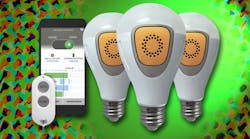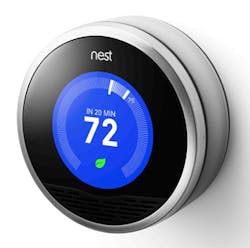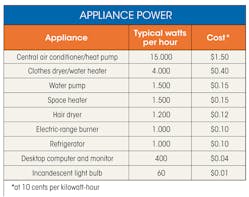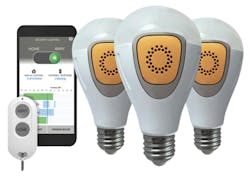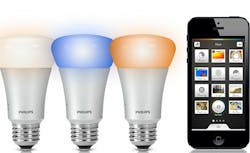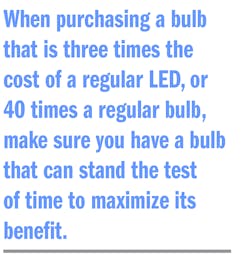This file type includes high-resolution graphics and schematics when applicable.
One of the main benefits of automated homes is their ability to save money and add convenience. However, to ensure your smart-home devices are making the most efficient and convenient home, you need to be cognizant of several aspects of this technology. This article will use a scientific method to determine where power goes, and the best ways to control it.
These systems have been honed over the years, so engineers be warned: You might not get the chance to design your own personal smart home, complete with HAL 9000’s voice from the movie A Space Odyssey. However, if you are more of the DIY engineer, the “Arduino and Instructables Smart-Home Projects” section at the end of the article provides links to Arduino projects that enable you to experiment on your own.
The Good and the Bad…and the Truth
Generally, the majority of cost in a home goes to thermodynamics: refrigerators, hot-water heaters, air conditioning, and heating. Old appliances can be a drain on energy. Online calculators are available to determine if a new refrigerator might help for Energy Star refrigerators and others.
While energy losses are improved with insulation—not necessarily a smart device—don’t throw away those smart outlets and lighting components. According to the U.S. Energy Information Administration, heating and air conditioning consumption reduced by 10% from 1993 to 2009. During the same time, appliances and lighting consumption increased 10%. As home efficiency improves and more electronic devices populate the home, this trend may continue.
Smart HVAC
The Good
For now, HVAC still consumes more energy than lighting and appliances. Typically, it only requires an upgrade to a single device to show improvement, rather that replacing many bulbs or plugs in a house. For new technology to work, it often must work seamlessly into the background. By using smart tools that learn the user’s behavior, smart thermostats are able to adjust the temperature of a space to minimize energy consumption without the user noticing a difference.
Apps will document and monitor the device’s performance and present information to educate users as necessary. Communicating with users on their energy usage, as well as indicating how they can save more, is often the best way to save money and create an efficient home.
The Bad
Not all devices are truly smart. The biggest savings and convenience are achieved through home automation—having lights, appliances, and the HVAC work without manually operating them.
Some “smart” devices are only programmable. For instance, programmable thermostat companies boasted the product would cut energy bills. However, a number of users didn’t take the time to program them properly, or read the instructions, and consequently didn’t notice much benefit. Some users actually reported an increase in HVAC cost. The inventors of the Nest said this “trend” gave them their inspiration.
The Truth
We are still in the early days, though, so any investments should be made with the future in mind. The thermostat is a good start, but more devices enter the home, you want them to be able to communicate together. For example, the Nest knows when you leave the house and can adjust the thermostat accordingly. If you have other Nest-friendly devices in your home, such as lighting and outlets, the Nest will act as a hub and turn them off when you leave the house, too. In this scenario, however, you may not want to plug your alarm clock into a smart outlet.
“While many users are firmly on one side or the other of the Apple versus Android battle, nobody wants to be locked in to an ecosystem that dictates what kind of smartphone they have to buy in the future, let alone which kind of smart home,” warns Todd Bernhard, CEO of NoTie, an app development firm. “Some companies have licensed their technology out, such as Amazon’s Alexa voice control. I can buy a speaker from Jam Audio and control my TV using my Logitech Harmony remote hub that will work with my HomeKit."
Finding devices that can communicate with a hub can help simplify a smart home. With everything integrated into a hub, "Smart-home technologies have the potential to bring the voice-based automation of Star Trek to today's homes,” continues Bernhard. “The leading platforms include Amazon's Alexa, Apple's HomeKit and to a lesser degree, Wink. While Amazon has a healthy head start, nobody should rule out the newer Google Home, either.”
However, the easier it is to access something might also mean it is easier to hack. Any IoT device may have security concerns—it is not just limited to door locks and video cameras. Voice control may allow a song or TV show to trigger a smart-home control.
"One concern that I haven't seen raised much is the potential for foul play,” notes Bernhard. “If you have an Amazon Echo device and someone on TV says something like ‘I'll ask a question’ or anything close to ‘Alexa,’ the speaker thinks you're asking a question. What if a TV show had someone say ‘Alexa, turn on all the lights!’ A harmless prank, right? Now, imagine leaving your window open just enough for an intruder to shout ‘Alexa, open the garage door.’”
He continues, “A mischievous coworker could say ‘Hey Siri, turn on my sprinklers,’ when you leave your phone unattended. We might need password protection on certain smart-home automation, or ideally biometric voice recognition, not just speech recognition. As with any technology, there are unexpected consequences. But that's the price to pay for boldly going where no one has gone before!"
Smart Outlets
The Good
Like the smart thermostat that educates users, outlets are offering monitoring to better mitigate power consumption. Standby-power loading can account for 10% of residential electric usage, according to Lawrence Berkeley National Laboratory (LBNL). The LBNL website has an excellent table that lists standby-power measurements for an array of appliances.
This loading scenario has many names—vampire or phantom load are two often-used terms. No matter what you call it, it sucks electricity when the device is off. Appliance companies have been working on this issue for some time. In fact, by 2010, many countries had implemented restrictions requiring appliances to not exceed 1 W in standby. By monitoring power, you can see if an old appliance or electronic device is wasting energy and might benefit from an automated or on/off feature.
The Bad
Saving 10% on your electric bill might sound good, but the average American home has 40 devices, according to LBNL. With the average smart outlet or plug running $30 to $70 a piece, a large investment would be needed to save around $11 a month. Lower-tech solutions are available, such as remote control plugs, to turn outlets on and off. A single plug might run around $10; five cost about $30.
For the engineers looking to hack and tinker, this may provide some fun. Available technology, such as universal remotes, could make it possible to hack the remote outlets to work with your smartphone or a single remote. Ultimately, however, it will be easier just to keep an eye out for smart-plug deals on the internet. Smart plugs are coming down in price, offer other features, and have plug-and-play apps.
Also keep in mind that while an outlet might offer power-outlet monitoring, there are two loads: a high load (when the device is in use) and a low load (standby power). An outlet should have both, but a company might not want to advertise the lack of, or quality, of monitoring provided by the outlet. In addition, these smart outlets use power to work, and should be considered.
The Truth
Most smart devices will use about half a watt. Lucid, a commercial building monitoring company, explains that the data collected by monitoring systems will educate people about how to better utilize their electricity. This, in return, will save more energy than what’s consumed by a system.
It is also important to know what devices need standby power. You can’t save money on appliances that need standby power to work. Another point is, unless the appliance picks up operation when power is restored, using a wireless button will not add any convenience.
For example, you can restore power to your computer, but the computer will not turn on just because the power returned. This gives engineers who don’t like canned systems a chance to play. But to save power, you have to know what outlets are consuming the most—and you don’t need a smart plug for that.
To find out about large power-consuming appliances, Energy.gov has an appliance calculator. There also are devices that only monitor power use: Kill A Watt, Ammeter, Blueline Powercost Monitor, TED 5,000, and the standby, Klein Multimeter, are just a few options. Once you pinpoint the outlets that are costing you the most, a power strip would probably be the most cost-effective approach to solve standby loading. However, if you are planning to buy a smart outlet because they are fun to play with, it’s best to buy one with power monitoring. Then use that outlet to identify its greatest return-on-investment, or convenience.
On the plus side, if you are a DIY type, open-source programmable outlets (and other projects) are still available. The Arduino library has some great projects that allow the more tech-savvy to program outlets, and they can be teamed up with your own or open-sourced apps. The Portlet is just one of the projects I found. Check out mechtechlab.com/portlet/ for files and assembly instructions. To find more, visit Arduino Libraries, or explore some of the links at the end of the article.
Smart Lighting
Outlets are not the only popular devices experiencing more companies competing in the smart-home market. The Philips Hue is probably the most recognized smart-lighting system currently available. Philips even offers a starter kit that includes colors. All of its lights communicate with a bridge that can handle up to 50 lights. Among other companies populating this space include GE, Insteon, Lifx, Osram, and a host of others.
The Good
Lighting can represent more than 500 kWh per year more than some of the appliances controlled by smart outlets (e.g., an entertainment center or computers), according to greenlivingideas.com. In turn, automatic smart lights might offer more convenience and savings than smart outlets.
Additional features can actually be seen—light can be turned on an off from anywhere, and many smart lights offer colors. Smart lights can help during a power outage too. I spoke to Martin Forest, CTO of BeOn Home, a smart lighting company. He says that BeOn Home offers a five-hour battery built directly into the bulb. If the power goes out, or you need a handy portable light, this bulb is always ready. The battery stays charged when the power is on, and if the battery is drained for any reason, it will recharge as soon as power is restored.
Reminiscent of the Clapper—a device that turn outlets on and off by clapping (remember this commercial?):
—Forest told me that BeOn Home uses sound technology to have the light respond to fire alarms or doorbells, and subsequently turning itself on. While these features might sounds pricey, there are cheaper versions of smart lights in the market. But remember, not all LEDs are created equal.
The Bad
The Energy Star website says, "LEDs have been efficient and long lasting in indicator lights in electronics for years, but using LEDs to create stable white light for general lighting presents new challenges.”
Not all LEDs may be as bright as rival technologies, they might not last as long or might alter shades of white over time, and they might flicker when dimmed. Moreover, there should be no standby load, with the exception of external controls (the smart features), whereby power shouldn't exceed 0.5 W.
When purchasing a bulb that is three times the cost of a regular LED, or 40 times a regular bulb, make sure you have a bulb that can stand the test of time to maximize its benefit. This is a good argument for avoiding "discount" smart lighting from unknown companies.
Well-known companies should be safe, but know what you are buying. While Philips boasts about offering 16 million colors and 50,000 shades of white, Hue has the added cost of using a bridge. The bridge communicates to all other lights—up to 50—and thus makes for a larger investment. This might be fine if you plan to buy many bulbs, or integrate more over time. But if you have a smaller home or apartment, the bridge may just add more expense.
The Truth
First, switching to LEDs will save you money, smart or not. A non-smart bulb may be around one-third the cost, so if you are doing this to save money, just get good-quality LED bulbs. However, if you have multiple people living in one home, the smart features can turn lights off if no one is around. If you have kids or a roommate that leaves their bedroom light on all day, investing the extra money into a smart bulb would probably be a good idea.
Overall, the savings achieved will depend on how often you use the light. To maximize savings, start with most-used lights. The Department of Energy published a report, breaking rooms into bed, bath, kitchen, living rooms, and exterior lighting. Exterior lighting consumed more than double the electricity than any two of the other rooms combined. The report also shows how minimal the usage of electric lighting is among many Americans.
Using the ledwave.com calculator, a lamp that’s on for about three hours a day has a break-even point at almost five years. On the other hand, a lamp that stays on for 12 hours a day will pay itself off in almost one year. These estimations are based on replacing a traditional light with an LED, and don't factor in the additional savings that might come from the automated program that could turn off lights that are left on. However, many companies offer an away lighting feature—turning lights on and off to look like someone's home. Turning lights on when no one is home will, of course, increase electric consumption.
For the DIYer, you can use open-source apps to control lighting. You could, for instance, receive a notification when lights are on or off, and turn them on and off based on anything. For example, the lights could be turned on as a selected stock goes up and off when it goes down. Open-source apps with connected bulbs allow tinkerers to get creative.
Once you have a fully integrated smart home, it might not be the cool futuristic home you thought. While smart homes sound great, most reviewers were unenthusiastic. Most smart-home devices didn’t get much praise until they were integrated enough to make a difference in energy costs. Other than creating a more efficient home, the convenience of control just leaves users reaching for their phones to open apps when a switch or button relatively close to them will accomplish the same action.
Currently, the trend of a smart home seems centered around the thermostat. Companies with open source code, or offering third parties an open-source code to patch their technology into others, will accelerate adoption of smart-home technology. Smart homes are about communication. Therefore, devices will have to communicate together in order to give the best benefit to the user.
For example, in May of this year, Nest offered an open thread for third-party companies to communicate with the smart thermostat. If, for example, your fitness tracker indicates you are asleep, it can turn off the lights and TV, and turn down the thermostat. When you wake, it can turn the lights back on and the temperature up. The same can be integrated with door locks, garage doors, motion sensors, and more to make sure you home is efficient and automated while working seamlessly in the background.
Arduino and Instructables Smart-Home Projects
With open-source libraries, you don’t have to be a programmer; just download the code. These projects are a great way to start understanding more complex systems like those in the Industrial Internet of Things (IIoT). Here’s a video on a smart-home project employing Arduino:
Check out some of Arduino's open-source libraries.
Visit this site to experiment with RF-based smart-home automation systems.
Watch a do-it-yourselfer build his own controller:
He has many other videos on how to use open-source microcontrollers for multiple automated home projects.
